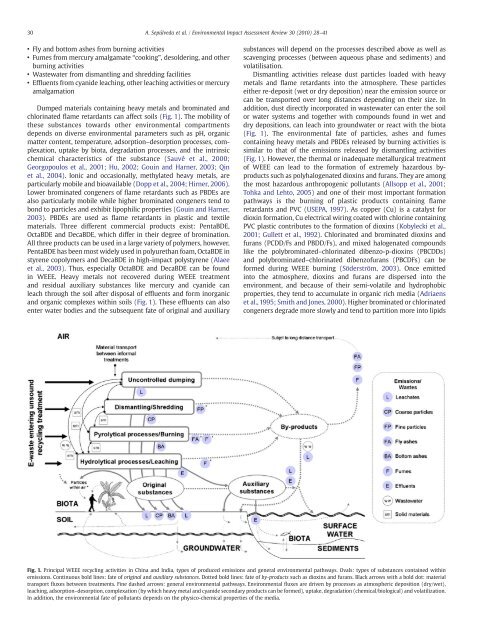A review of the environmental fate and effects of hazardous ...
A review of the environmental fate and effects of hazardous ...
A review of the environmental fate and effects of hazardous ...
Create successful ePaper yourself
Turn your PDF publications into a flip-book with our unique Google optimized e-Paper software.
30 A. Sepúlveda et al. / Environmental Impact Assessment Review 30 (2010) 28–41• Fly <strong>and</strong> bottom ashes from burning activities• Fumes from mercury amalgamate “cooking”, desoldering, <strong>and</strong> o<strong>the</strong>rburning activities• Wastewater from dismantling <strong>and</strong> shredding facilities• Effluents from cyanide leaching, o<strong>the</strong>r leaching activities or mercuryamalgamationDumped materials containing heavy metals <strong>and</strong> brominated <strong>and</strong>chlorinated flame retardants can affect soils (Fig. 1). The mobility <strong>of</strong><strong>the</strong>se substances towards o<strong>the</strong>r <strong>environmental</strong> compartmentsdepends on diverse <strong>environmental</strong> parameters such as pH, organicmatter content, temperature, adsorption–desorption processes, complexation,uptake by biota, degradation processes, <strong>and</strong> <strong>the</strong> intrinsicchemical characteristics <strong>of</strong> <strong>the</strong> substance (Sauvé et al., 2000;Georgopoulos et al., 2001; Hu, 2002; Gouin <strong>and</strong> Harner, 2003; Qinet al., 2004). Ionic <strong>and</strong> occasionally, methylated heavy metals, areparticularly mobile <strong>and</strong> bioavailable (Dopp et al., 2004; Hirner, 2006).Lower brominated congeners <strong>of</strong> flame retardants such as PBDEs arealso particularly mobile while higher brominated congeners tend tobond to particles <strong>and</strong> exhibit lipophilic properties (Gouin <strong>and</strong> Harner,2003). PBDEs are used as flame retardants in plastic <strong>and</strong> textilematerials. Three different commercial products exist: PentaBDE,OctaBDE <strong>and</strong> DecaBDE, which differ in <strong>the</strong>ir degree <strong>of</strong> bromination.All three products can be used in a large variety <strong>of</strong> polymers, however,PentaBDE has been most widely used in polyurethan foam, OctaBDE instyrene copolymers <strong>and</strong> DecaBDE in high-impact polystyrene (Alaeeet al., 2003). Thus, especially OctaBDE <strong>and</strong> DecaBDE can be foundin WEEE. Heavy metals not recovered during WEEE treatment<strong>and</strong> residual auxiliary substances like mercury <strong>and</strong> cyanide canleach through <strong>the</strong> soil after disposal <strong>of</strong> effluents <strong>and</strong> form inorganic<strong>and</strong> organic complexes within soils (Fig. 1). These effluents can alsoenter water bodies <strong>and</strong> <strong>the</strong> subsequent <strong>fate</strong> <strong>of</strong> original <strong>and</strong> auxiliarysubstances will depend on <strong>the</strong> processes described above as well asscavenging processes (between aqueous phase <strong>and</strong> sediments) <strong>and</strong>volatilisation.Dismantling activities release dust particles loaded with heavymetals <strong>and</strong> flame retardants into <strong>the</strong> atmosphere. These particlesei<strong>the</strong>r re-deposit (wet or dry deposition) near <strong>the</strong> emission source orcan be transported over long distances depending on <strong>the</strong>ir size. Inaddition, dust directly incorporated in wastewater can enter <strong>the</strong> soilor water systems <strong>and</strong> toge<strong>the</strong>r with compounds found in wet <strong>and</strong>dry depositions, can leach into groundwater or react with <strong>the</strong> biota(Fig. 1). The <strong>environmental</strong> <strong>fate</strong> <strong>of</strong> particles, ashes <strong>and</strong> fumescontaining heavy metals <strong>and</strong> PBDEs released by burning activities issimilar to that <strong>of</strong> <strong>the</strong> emissions released by dismantling activities(Fig. 1). However, <strong>the</strong> <strong>the</strong>rmal or inadequate metallurgical treatment<strong>of</strong> WEEE can lead to <strong>the</strong> formation <strong>of</strong> extremely <strong>hazardous</strong> byproductssuch as polyhalogenated dioxins <strong>and</strong> furans. They are among<strong>the</strong> most <strong>hazardous</strong> anthropogenic pollutants (Allsopp et al., 2001;Tohka <strong>and</strong> Lehto, 2005) <strong>and</strong> one <strong>of</strong> <strong>the</strong>ir most important formationpathways is <strong>the</strong> burning <strong>of</strong> plastic products containing flameretardants <strong>and</strong> PVC (USEPA, 1997). As copper (Cu) is a catalyst fordioxin formation, Cu electrical wiring coated with chlorine containingPVC plastic contributes to <strong>the</strong> formation <strong>of</strong> dioxins (Kobylecki et al.,2001; Gullett et al., 1992). Chlorinated <strong>and</strong> brominated dioxins <strong>and</strong>furans (PCDD/Fs <strong>and</strong> PBDD/Fs), <strong>and</strong> mixed halogenated compoundslike <strong>the</strong> polybrominated–chlorinated dibenzo-p-dioxins (PBCDDs)<strong>and</strong> polybrominated–chlorinated dibenz<strong>of</strong>urans (PBCDFs) can beformed during WEEE burning (Söderström, 2003). Once emittedinto <strong>the</strong> atmosphere, dioxins <strong>and</strong> furans are dispersed into <strong>the</strong>environment, <strong>and</strong> because <strong>of</strong> <strong>the</strong>ir semi-volatile <strong>and</strong> hydrophobicproperties, <strong>the</strong>y tend to accumulate in organic rich media (Adriaenset al., 1995; Smith <strong>and</strong> Jones, 2000). Higher brominated or chlorinatedcongeners degrade more slowly <strong>and</strong> tend to partition more into lipidsFig. 1. Principal WEEE recycling activities in China <strong>and</strong> India, types <strong>of</strong> produced emissions <strong>and</strong> general <strong>environmental</strong> pathways. Ovals: types <strong>of</strong> substances contained withinemissions. Continuous bold lines: <strong>fate</strong> <strong>of</strong> original <strong>and</strong> auxiliary substances. Dotted bold lines: <strong>fate</strong> <strong>of</strong> by-products such as dioxins <strong>and</strong> furans. Black arrows with a bold dot: materialtransport fluxes between treatments. Fine dashed arrows: general <strong>environmental</strong> pathways. Environmental fluxes are driven by processes as atmospheric deposition (dry/wet),leaching, adsorption–desorption, complexation (by which heavy metal <strong>and</strong> cyanide secondary products can be formed), uptake, degradation (chemical/biological) <strong>and</strong> volatilization.In addition, <strong>the</strong> <strong>environmental</strong> <strong>fate</strong> <strong>of</strong> pollutants depends on <strong>the</strong> physico-chemical properties <strong>of</strong> <strong>the</strong> media.
















